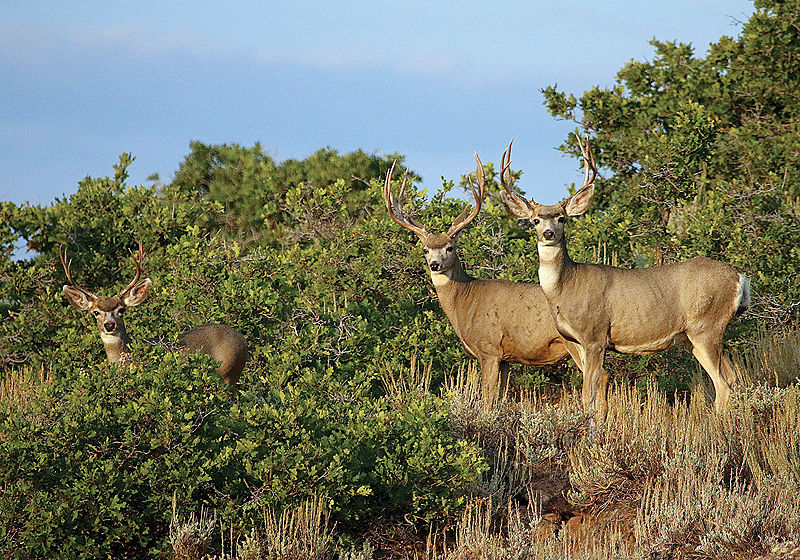Early-season rifle hunt
Holding an early-season rifle hunt, on 10 general season deer hunting units in Utah, is one of the DWR’s proposals.
The hunt would run Oct. 10 – 14 on the Kamas, Chalk Creek, East Canyon and Morgan/South Rich units in northern Utah, the Nine Mile unit in southeastern Utah, and the Fillmore, Fishlake, Panguitch Lake, Pine Valley and Zion units in south-central and southwestern Utah.
Jones says holding the hunts would help manage buck-to-doe ratio objectives on the units and help reduce hunter crowding.
“Hunter crowding is one of the major challenges general deer hunters face,” he says. “Holding an early hunt would shift some of the hunters out of the regular hunt and into the earlier hunt. And that means fewer hunters would be in the field during the regular hunt.”
Late-season limited-entry muzzleloader buck deer hunt
A chance to hunt buck deer with a muzzleloader—after the general rifle hunt—was offered on a few units in 2016. In 2017, the opportunity was expanded to 15 units. Starting in 2018, biologists would like to offer the opportunity on all of Utah’s general season deer hunting units.
In the past, a late-season muzzleloader hunt could not be held on a unit unless the number of bucks per 100 does was over the minimum objective of either 15 to 17 bucks per 100 does, or 18 to 20 bucks per 100 does, depending on the unit.
“We’d like to change that,” Jones says. “We’d like to offer that opportunity not only on units that are over their objective but also on units that are meeting their objective. And, all of the units in Utah are currently meeting their minimum bucks per 100 does objective.”
Jones says only a limited number of permits would be offered for the late-season muzzleloader hunt. He says hunters who have drawn these permits in the past have enjoyed the chance to hunt deer later in the fall. “Fewer hunters are in the field with you,” he says, “and the bucks are a little less wary as the breeding season approaches.”
Hunt all three elk seasons
With a statewide population of more than 80,000 animals, Utah has plenty of elk. And hunter success rates for these wary animals is fairly low. For those reasons, biologists would like to allow general season bull elk hunters a chance to hunt all three general elk seasons—archery, rifle and muzzleloader.
If approved, those who bought a permit for all three seasons would first choose whether they wanted to hunt on spike-only units or any-bull units. Then, after buying their over-the-counter permit, they could hunt during the archery season on any general season bull elk unit in the state. During the rifle and muzzleloader hunts, they’d have to hunt on the type of unit for which they bought a permit. Their permit would allow them to take only one elk, so their elk hunt would end for the year as soon as they took an elk.
“We’d closely monitor the number of elk taken,” Jones says. “If that number went beyond the limit set in the state’s elk management plan, we’d relook at whether the opportunity should be offered again in 2019.”
A permit to hunt bull elk during one of the three general seasons costs Utah residents $50. A permit to hunt bull elk during all three general seasons would cost $150.
“Cactus buck” hunt
With one exception, “cactus bucks”—buck deer that typically can’t reproduce—are found in very few places in Utah.
The one exception is the famed Paunsaugunt premium limited entry unit in southwestern Utah. There, a small population of cactus bucks is found. Biologists would like to give more hunters a chance to hunt them.
Cactus bucks are easy to distinguish: they still have velvet on their antlers late into the fall.
Jones says those who draw a permit for the Paunsaugunt unit can take a cactus buck now, but most don’t, opting instead to take one of the massive bucks on the unit.
“Offering a cactus buck-only hunt would allow more people to hunt this amazing unit and take bucks hunters aren’t currently taking,” Jones says. “Cactus bucks typically can’t reproduce, so taking these bucks would not have a negative effect on the population.”
Southeastern Region proposed changes

Some hunters get to see a selection of deer with antlers but most of the time they do not. Photo by DWR
